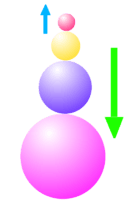Galilean cannon

A Galilean cannon is a device that demonstrates conservation of linear momentum.[1] It comprises a stack of balls, starting with a large, heavy ball at the base of the stack and progresses up to a small, lightweight ball at the top. The basic idea is that this stack of balls can be dropped to the ground and almost all of the kinetic energy in the lower balls will be transferred to the topmost ball - which will rebound to many times the height from which it was dropped. At first sight, the behavior seems highly counter-intuitive, but in fact is precisely what conservation of momentum predicts. The principal difficulty is in keeping the configuration of the balls stable during the initial drop. Early descriptions involve some sort of glue/tape,[2] tube, or net[3] to align the balls.
A modern version of the Galilean cannon was sold by Edmund Scientific Corporation and is still sold as the Astroblaster.[4][5] In this device, a heavy wire is threaded through all of the balls to keep them accurately aligned - but the principle is the same. The resulting rebound is quite powerful; in fact, eye safety issues became so prevalent that this toy now comes with safety goggles.
It is possible to demonstrate the principle more simply with just two balls (a basketball and a tennis ball, for example). Balance the tennis ball on top of the basketball and drop the pair to the ground. The tennis ball will rebound to many times the height from which it was released.[6]
The Guinness world record for the tallest Galilean cannon drop ever was set by Dr. Brian Greene on the May 25, 2016 episode of The Late Show with Stephen Colbert.[7]
See also
References
- ↑ Dewdney, Alexander (July 1992). "Fossil statistics, forecasting the forecaster, and the Galilean cannon". Science Probe! magazine. pp. 97–100.
- ↑ Mellen, W. R. (1968). "Superball Rebound Projectiles". American Journal of Physics. 36 (9): 845–841. Bibcode:1968AmJPh..36..845M. doi:10.1119/1.1975164.
- ↑ Mellen, W. R. (1995). "Aligner for elastic collisions of dropped balls". The Physics Teacher. 33: 56–51. Bibcode:1995PhTea..33...56M. doi:10.1119/1.2344135.
- ↑ Astro-blaster, Educational Innovations Inc.
- ↑ Kireš, M. N. (2009). "Astroblaster—a fascinating game of multi-ball collisions". Physics Education. 44 (2): 159. Bibcode:2009PhyEd..44..159K. doi:10.1088/0031-9120/44/2/007.
- ↑ Cross, R. (2007). "Vertical bounce of two vertically aligned balls". American Journal of Physics. 75 (11): 1009–1001. Bibcode:2007AmJPh..75.1009C. doi:10.1119/1.2772286.
- ↑ The Late Show with Stephen Colbert. YouTube. May 25, 2016. Retrieved May 26, 2016.